Intel Core Duo: AOpen i975Xa-YDG to the Rescue
by Gary Key on May 4, 2006 8:00 AM EST- Posted in
- Motherboards
Board Layout
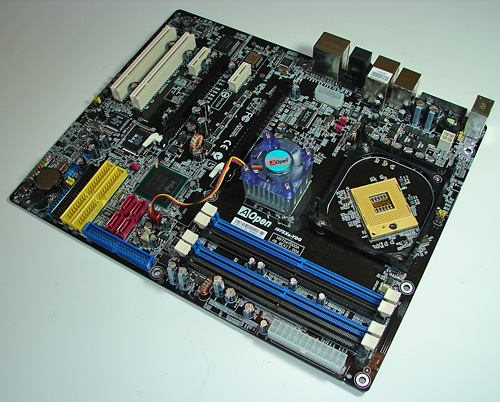
AOpen designed a very well laid out board with all major connections easily reached. The board is lacking most clearance issues and was very easy to install in a mid-size ATX case. The board features an excellent voltage regulator power design along with Rubycon capacitors that yielded superb stability and overclocking results. Here's an enhanced close-up of the capacitors area.

The DIMM module slots' color coordination is correct for dual channel setup based upon the premise of utilizing different colors for each memory bank. The memory modules are easy to install with a full size video card placed in the first PCI Express X16 slot. The 24-pin ATX power connector is located along the upper edge of the board and below the memory modules.
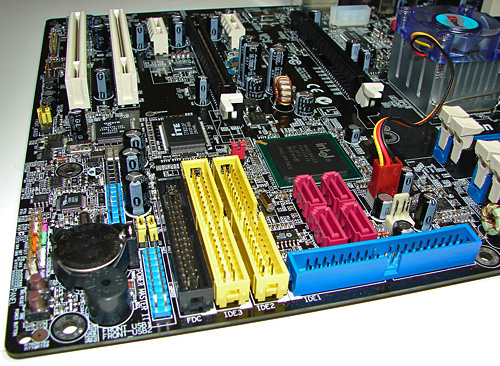
The Intel IDE port connector is the blue IDE socket located along the edge of the board and to the right of the memory modules. This port did not present any connection issues in our mid-size ATX case. The system and Northbridge fan headers are located above the IDE1 port and to the left of the Intel SATA ports.
The four Intel SATA ports are a reddish-pink color and are conveniently located below the Intel ICH7 Southbridge. The SATA ports feature the newer clamp and latch design. We found the positioning of the SATA ports to be excellent when utilizing the PCI-E slots or the Intel IDE port connector. The Intel ICH7 Southbridge does not require a heatsink in this application.
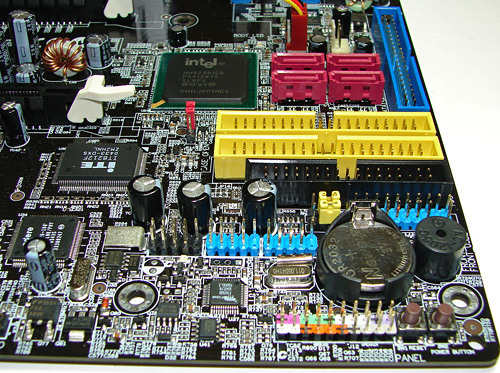
The two yellow IDE port connectors are provide by the ITE chip and are located below the Intel SATA ports. These ports did not present any connection issues in our mid-size ATX case although they could potentially interfere with the SATA ports or might cause a cable length issue in full size ATX cases.
The black floppy drive connector is positioned below the ITE IDE ports. The location of this connector is not ideal and actually the whole point of having a floppy drive connector is becoming moot with the wide spread availability of USB floppy or flash drives along with BIOS support for boot purposes.
The blue IR port is located below the floppy drive connector and above the battery. This connector is required for the Remote Control unit. Take note of the yellow jumpers; if they are not installed correctly the Remote Control unit will not operate correctly. The jumper configuration is not mentioned in the manual.
The nine pins on the black plastic base provide an additional IEEE-1394 connector; this connection is located to the left of the two additional blue USB connectors - not to be confused with the blue IR connection. The chassis panel connections are located at the bottom edge of the board below the battery. AOpen also provides onboard reset and power buttons, a feature that is greatly appreciated and very useful for boards not in a case. Last and actually least used is the clear CMOS jumper block that is a traditional jumper design located below the Intel ICH7 and to the left of the ITE IDE connectors. We did not utilize this jumper throughout our two weeks of testing this board and AOpen should be commended for their BIOS self recovery system and general board stability.
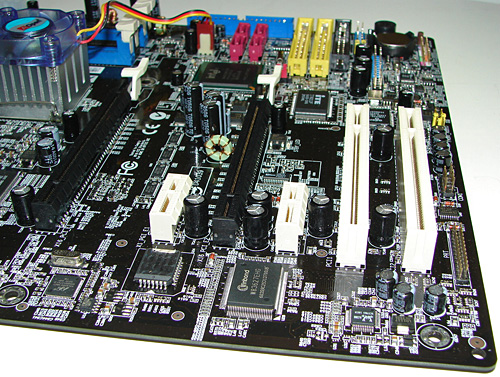
The board comes with (2) physical PCI Express X16 connectors, (2) PCI Express X1 connectors, and (2) PCI 2.3 connectors. The layout of this design offers a good balance of expansion slots for a mainstream board while providing excellent clearance space for card utilization. AOpen designed a two slot opening between the first X16 PCI-E connector and the first X1 PCI-E connector, allowing you to utilize the X1 connector with a dual slot cooling system.
The primary PCI Express X16 connector is located to the far left of the slot areas. The first PCI Express X1 connector is located next, followed by the secondary PCI Express X16 connector. The second PCE Express X1 connector is next, and then last are the (2) PCI slots. Although there are two physical X16 connectors available on the board, they operate in X8 PCI-E mode in multi-GPU or CrossFire mode.
We did not have any issues installing our EVGA 7900GTX 512MB or ATI X1900XTX video cards in the first or second X16 PCI Express slots. A dual slot card located in the second X16 connector will physically render the second PCI Express X1 slot useless. There were no issues utilizing this slot with video cards containing single slot cooling systems.
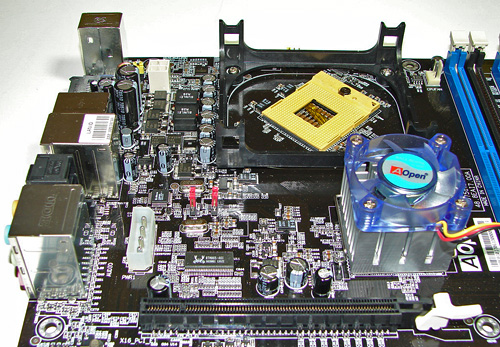
Returning to the CPU socket area, we find an ample amount of room for alternative cooling solutions. We utilized the supplied AOpen heatsink/fan but also verified a couple of Socket-478/9 cooling solutions would fit in this area during our tests. However, due to the low voltages utilized and resulting thermal output, the supplied AOpen heatsink/fan worked fine throughout our testing. The CPU socket is rotated at a 45 degree angle, which we have seen in past Pentium-M configurations.
The Intel 975X Northbridge is actively cooled with a medium sized heatsink/fan unit that did not interfere with any installed peripherals. In fact this unit kept the chipset cool enough that additional chipset voltage was not a factor in our overclocking tests. Our only concern is the lifespan of the fan but it is very quiet during operation. Our advice to AOpen is to install a more effective passive heatsink design and drop the fan as our overclock testing showed no differences between the fan operating or not.
AOpen places the four-pin 12v auxiliary power connector at the top of the CPU socket area but out of the way of aftermarket cooling solutions. The four-pin Molex power connector is located above the first X16 PCI-E connector and must be utilized for multi-GPU or CrossFire operation. This connector is located in a position that can hamper airflow with cabling that crosses directly over the CPU heatsink/fan, though power supplies with longer cables will usually allow you to route cables around the CPU.
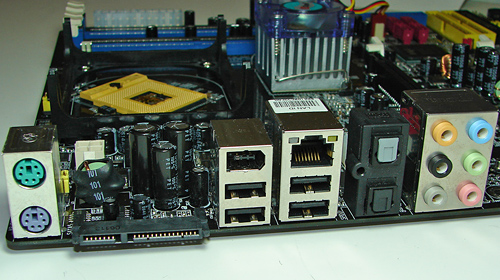
The rear panel contains the standard PS/2 mouse and keyboard ports, LAN port, and 4 USB ports. The LAN (RJ-45) port has two LED indicators representing Activity and Speed of the connection. The audio panel consists of 6 ports that can be configured for 2, 4, 6, and 8-channel audio connections. The rear panel also has two S/PDIF optical ports (In/Out), IEEE-1394 port, and a powered external SATA 3Gb/s port.
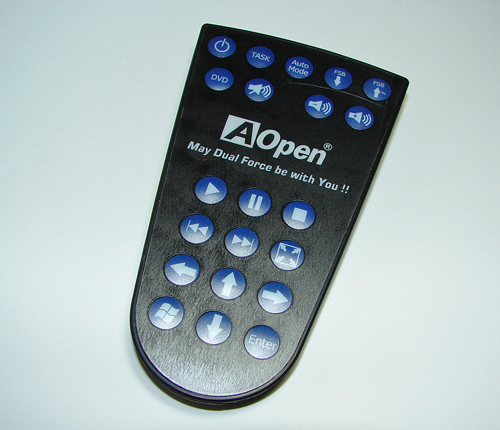
One of the more interesting options we have seen in a motherboard kit is this remote control unit from AOpen. Its main purpose is to control Windows Media Player functions but AOpen designed system on/off and FSB overclocking capability into the mix. Both of these functions proved valuable during the course of our testing, especially the FSB settings as we explored the overclocking limits of our board. (Just don't let your toddler have too much fun pressing buttons on the remote!)










81 Comments
View All Comments
Viditor - Thursday, May 4, 2006 - link
Premiere Pro 2.0 has a 64 bit version that works very well. It has not yet been "optimized" for 64 bit (meaning that basic functions won't run much faster), but you have access to 4 GB+ of memory (which can be a HUGE help when dealing with very large movie and audio files).http://www.adobe.com/products/premiere/pdfs/premie...">Adobe Premiere Pro 2.0 pdf
Griswold - Thursday, May 4, 2006 - link
This was obviously a test of a mobile CPU on a desktop platform, so his point is valid. And what does SFF have to do with it?Calin - Thursday, May 4, 2006 - link
That more than 50% overclock is mind boggling - I hope this will bode well for the soon-to-be released Intel processors. Performance as good as or better than Opteron 175? Looks like Intel already have this side of the market covered.xsilver - Thursday, May 4, 2006 - link
have intel chipset limitations been discussed on the upcoming conroe?wont all conroes be runnning 1066fsb already? meaning there is little headroom left for fsb overclocking unless some serious progress is made on the new chipsets?
(300ish fsb is the current general limit for intel chipsets right?)
Gary Key - Thursday, May 4, 2006 - link
We felt guilty when raising the voltage up to 1.3875 as temps increased from 25c to 31c, makes you wonder what a really good heatsink/fan will on this board. :) Anyway, I think we reached the limit of our board around 267fsb in further testing with a water cooling unit. I am sure the CPU had more in it as temps were around 26c at load, or maybe not. We spoke with AOpen and it appears the boards will top out around 275FSB at this time, we had an early board and based upon some user experiences the retail boards are doing around 275 at this time. We have a retail board on the way for our HTPC article.
Griswold - Thursday, May 4, 2006 - link
What was the ambient (room) temperature?Gary Key - Thursday, May 4, 2006 - link
It varies during the day, variation is 20c~22c. There is a new program out that will measure the Yonah core temperature through the on-chip diode instead of the AOpen thermal sensor. I withheld our temperature and power consumption numbers until we decide which temperature reading to report as another utility in XP gives a slightly different reading also. Power consumption is excellent.
Our test system (11x255, ~2.8GHz)-
X1900XT
idle - 114w
load - 232w
X1900 CrossFire (P4 of video cards)
idle - 139w
load - 357w
redbone75 - Thursday, May 4, 2006 - link
That price is a bit daunting for a mobo. This is where if you absolutely have to build a PC right now I would go with an AMD system b/c you still get stellar performance at a lower price point. The A8R32-MVP is a little under $200, and the Opty 165 still costs less than the Core Duo T2400. So, although this is a great effort from Aopen, I personally would build the AMD system or just wait for Conroe/Merom to launch. Boy, but does this make your mouth water if you choose the latter, doesn't it?dexvx - Sunday, May 7, 2006 - link
Lol, what happened to the fanboi arguement of saving power for the long term (if you visit the AT forms, its frequently used arguement for not buying a cheap Pentium-D system)? Based on the powerdraw tests from Tech-report.com, you save more power going from a X2 to Yonah than from Pentium-D to X2.That Aside, this Aopen board *is* Meron compatible with a bios update. The folks over at xtremesystems.org has confirmed it.
Schmeh - Thursday, May 4, 2006 - link
I absolutely agree. I have been putting of upgrading my system for almost a year and I am glad that I did. I can't wait to see what Conroe and Merom have to offer. My only fear is that Intel will overprice them at launch.